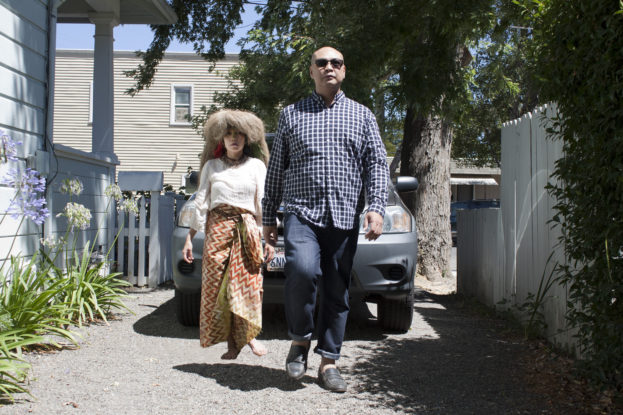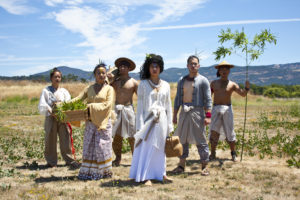

In a lush tropical forest speckled with dappled light and alive with the sounds of wildlife, a shape shifting deity turns herself into a wild animal that is pursued and cornered by a hunter. The animal attacks the hunter who gets hurt and loses consciousness. The hunter wakes up in the enchanted forest and is cared for by a goddess until he is healed. The hunter falls in love with her and his spirit is torn between two worlds–his heart and the society he lives in. Thus begins the story of Ba-e Makiling, a contemporary creation of an age-old Philippine myth commissioned by Kularts from collaborators master Philippine Dance choreographer Jay Loyola, composer Florante Aguilar, director Alleluia Panis, with costume design by June Arellano.
The third in a series of commissioned works based on the elements of air, water, earth, and fire (the first being Palau’an Bird Call-Huni ng Tandikan for air then Ma- ség, Typhoon for water) as contemporary re-imaginations of Pilipino culture before European colonization, Ba-e Makiling is the collaborators’ re-imagination of the myth of Mariang Makiling, a pre-colonial tale that has, in its present guise, survived total obliteration from the effects of colonization.
Mariang Makiling (“Maria” being a Hispanicization of the term lady) is a pre-colonial deity or diwata who is the residential guardian spirit of Mount Makiling in the province of Laguna, Philippines. The mountain is believed to be the profile of the reclining diwata, with its various peaks representing her face, breasts, and her hair cascading down into a slope. Like the dormant volcano Mount Makiling, classified as being potentially active, Mariang Makiling, is believed to be a deity with the same powerful fiery abilities to destroy and create.
A young and ageless brown-skinned beauty with long silky black hair reaching the forest floor, eyes that sparkle, and decked in radiant white clothing, the diwata is also believed to bathe in the waters of Laguna de Ba-e, literally “lake of the lady,” the largest lake in the Philippines at the foot of Mount Makiling. Director Alleluia Panis cites the stories told by her father about his hometown Los Baños, Laguna as the inspiration for the piece. “He would always say Laguna de Bai or Laguna de Ba-e.” Panis thought that her father was mispronouncing the English word “bay” but then learned from her father ‘bay’ or ‘bae’ in classic Tagalog means lady not the English word ‘bay,’ and therefore the title of the piece “Ba-e Makiling.”
Recreating a History and Identity
Sharing a common goal to recreate and reclaim a history and cultural identity marred by colonization, the artists collaboratively created the structure of the work: the characters, storyline, treatment, and everything that makes up the imagined universe of the dance piece. Panis says that the inception of the project happened two years ago. “After about a month of rigorous discussions, we decided that Ba-e Makiling is the story we want to explore, and reimagine what the Tagalog region might have been like prior to European contact.”
Anchoring the choreography on what is known as “barrio dances,” in Philippine folkloric parlance, and an indigenous spiritual belief system, Loyola reveals that the piece is an investigation on the deconstruction of rural dances of the Luzon and Visayas islands of the Philippines. Through innovation, the “dance movements will be explored by tracking back the origin of the movements to its indigenous method by removing the Hispanic patterns and form.”
These “barrio” or traditional dances—now performed during village celebrations honoring the patron saint, to give thanks for a good harvest, and the coming of the life-giving monsoon rains—have their roots in pre-colonized cultures of the islands now known as the Philippines and were performed to honor and pay homage to an indigenous deity. At the advent of Christianization of the indigenous population, these “pagan” dances were “disguised,” transformed into “barrio” dances, to prevent them from being banned by the Spanish Catholic priests, fabricating the stereotypical concept of “happy natives” celebrating in an idyllic setting. Ba-e Makiling will investigate, explore, and expose the hidden characteristics of these “celebratory” dance forms, their connections to other indigenous forms of warrior arts, spirituality, rituals, and tribal justice.
The investigation and exploration of a past that could have been is reflected on the sounds and rhythm of the music that propels the choreography. Drawing inspiration from indigenous musical forms, with their own rhythmic and melodic complexities, and the highly percussive nature of traditional music prevalent in South East Asia, Aguilar says that most of the music for Ba-e Makiling “is produced by pounding on a surface.”
An amalgamation of styles and influences was put into the costume design, incorporating a variety of fabrics and textures into the mix. Arellano had free reign, working with a seamstress in the Philippines, to create the different looks for the characters that went beyond the stereotype of what indigenous people wear while imagining how the aesthetics of clothing could be in this imagined world.
Revisiting the past to imagine and recreate it in the present, the various elements of the production are fundamentally inspired by the still existing indigenous cultures from the north and south of the Philippines that have persisted, maintaining their rich heritage, in spite of oppression then and now. Panis says,
“They are the most valuable resource, a most important reference on how we created the universe of Ba-e Makiling.”
Creative Collaboration
The creative process behind Ba-e Makiling is highly collaborative. Rooted in the Filipino concept of bayanihan or communal effort. It has several moving parts with Panis at the helm as director, Loyola as choreographer, Aguilar as composer, and Arellano as costume designer. Add to that a group of dancers of different backgrounds and disciplines, all contributors themselves, then you get something akin to an organism with independent and vital organs working separately but unified by an underlying concept that ultimately comes together in an act of discovering and creating itself. The process is unorthodox and Panis’ approach to the project is like a film director with Loyola in the role of a “screenwriter,” Aguilar as composer, Arellano as designer, and the dancers as “actors.” Panis explains, “Jay builds the movement structure for each dance section. I’m responsible for the choreography, staging, costumes, props, stage set, and lighting to all cohesively and effectively work together to serve the narrative.”
The method to the madness has its share of challenges. Aguilar’s experience in composing music for dance theater is the opposite of writing music for film where you have a visual cue. “There are no visuals because they are waiting for me to deliver the music before the choreography,” says Aguilar. “All you have is an outline script with time requirements. Sometimes there’re mood indications, sometimes not.” As with the music, designing costumes prior to seeing the choreography has not been a seamless process, resulting in incompatibilities. “There were a lot of rethinking and repairs to be done,” says Arellano.
Challenges aside, the method, where key elements of the production function independently, makes for true creative collaboration. “The music is not an afterthought but rather at the forefront along with the dance,” says Aguilar. “The composer can affect and drive the storytelling aspect.” The same is true with the dancers who have the opportunity to contribute movement phrases and develop their own interpretation of the characters. “It’s always a treat to actively contribute to the content of the work. It’s thrilling to be part of an original cast of a premiering piece,” says Isa Musni who is dancing in the lead role. Jonathan Mercado, dancing in the role of Lakai, sums up his experience as a meshing of “Filipino and contemporary dance, a couple degrees of acting, and a sea of imagination. Everything is pivotal to making this story come alive.”
As with all creative endeavors, somehow, it all comes together well in the end, with
the challenges being an integral part of the process. “I’ve learned to listen to, learn from, and depend on one another in this production more than I have in many others,” says dancer Stephanie Herrera. “It’s really an honor to be present in this creative process.”
The Pilipino Experience
Centuries of colonization have rendered the Pilipino with a fractured identity. Yet vestiges of an indigenous self is visible between the cracks, but one has to look hard. And like finding remnants of an artifact with missing pieces, one has no option but to imagine the possibilities that could fill the gaps in between. This process of rediscovering and reclaiming an indigenous self is at the heart of the Pilipino experience. For artists like Panis it is crucial work. She stresses “the great importance for Pilipinos in the diaspora to be empowered to imagine, to create, and reflect their experiences on the stage, screen, and other artistic mediums.”
In Ba-e Makiling the clues to an indigenous past is deciphered from the movements and features of traditional Philippine dances and rituals that have been deconstructed to reveal their true essences which had been forcibly concealed as a way to protect and preserve them from being erased by the forces of colonization. Like the term “Ba-e” that was switched to “Maria,” it may seem like something else yet it is inherently the same. The story of a love affair between man and deity is explored as a metaphor for re-discovering and reclaiming the indigenous self, of awakening an identity that lies dormant in each and every one of us.
Ba-e Makiling will be staged at Bindlestiff Studios, located in what is now known as the SoMa Pilipinas: Filipino Cultural District, at the South of Market in San Francisco. This work is made possible with support from the National Endowment for the Arts, San Francisco Arts Commission, and the Zellerbach Family Foundation.


